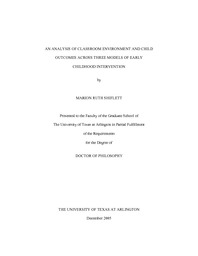
ATTENTION: The works hosted here are being migrated to a new repository that will consolidate resources, improve discoverability, and better show UTA's research impact on the global community. We will update authors as the migration progresses. Please see MavMatrix for more information.
Show simple item record
| dc.contributor.author | Shiflett, Marion Ruth | en_US |
| dc.date.accessioned | 2007-08-23T01:56:46Z | |
| dc.date.available | 2007-08-23T01:56:46Z | |
| dc.date.issued | 2007-08-23T01:56:46Z | |
| dc.date.submitted | November 2005 | en_US |
| dc.identifier.other | DISS-1155 | en_US |
| dc.identifier.uri | http://hdl.handle.net/10106/453 | |
| dc.description.abstract | This research study presents a comparative analysis to examine classroom environments and child developmental outcomes across three early intervention models that serve children living in low-income families. Two long standing early intervention programs, Head Start and state-mandated Prekindergarten, are used as comparison groups to compare classroom environment and child outcomes with a collaboration known as Ready Start, a combination program serving children with a half day of Prekindergarten and a half day of Head Start. The Ready Start program is designed to combine the strengths of both programs to best serve the needs of children from low-income families. The study sample was drawn from existing data from a longitudinal study begun in the 2001-2002 school year. The population from which the sample came was children enrolled in a Head Start program for four-year-olds and children enrolled in the Prekindergarten program of a large urban school district, which included children in the Ready Start program. Analysis of Variance (ANOVA) was used to compare supportive environments using scale score means from the Assessment Profile for Early Childhood Programs, Research Edition II, describing the learning environment, scheduling, curriculum, interacting and individualizing practices. The results of the ANOVA found Ready Start with highest means among the programs on each scale assessing the classroom environment with the exception of non-significant differences between Ready Start and Head Start on the Scheduling and Individualizing scales. Multivariate Analysis of Covariance (MANCOVA) was used to compare child outcome data across programs, controlling for the initial differences of groups. Posttest scores from the Preschool Language Scale-3 and the Developing Skills Checklist operationalize child outcomes. Pretest scores from both assessments serve as covariates. For the two subscales of the PLS-3 and the five scales of the DSC, Ready Start scores met or exceeded the scores for the comparison groups. Implications for future research and social work practice are addressed. | en_US |
| dc.description.sponsorship | Mindel, Charles | en_US |
| dc.language.iso | EN | en_US |
| dc.publisher | Social Work | en_US |
| dc.title | An Analysis Of Classroom Environment And Child Outcomes Across Three Models Of Early Childhood Intervention | en_US |
| dc.type | Ph.D. | en_US |
| dc.contributor.committeeChair | Mindel, Charles | en_US |
| dc.degree.department | Social Work | en_US |
| dc.degree.discipline | Social Work | en_US |
| dc.degree.grantor | University of Texas at Arlington | en_US |
| dc.degree.level | doctoral | en_US |
| dc.degree.name | Ph.D. | en_US |
Files in this item
- Name:
- umi-uta-1155.pdf
- Size:
- 16.21Mb
- Format:
- PDF
This item appears in the following Collection(s)
Show simple item record


